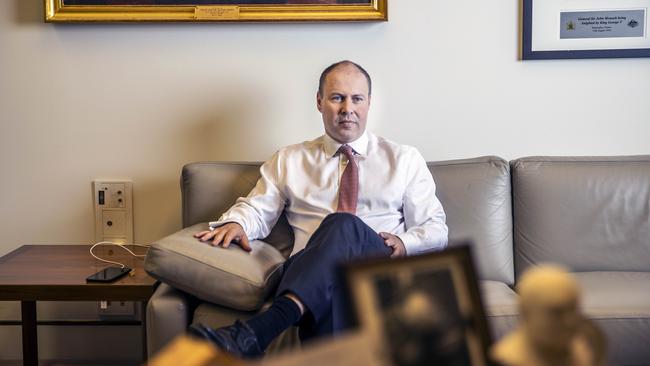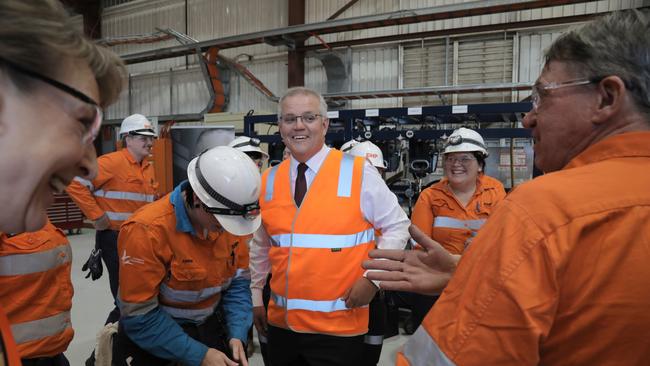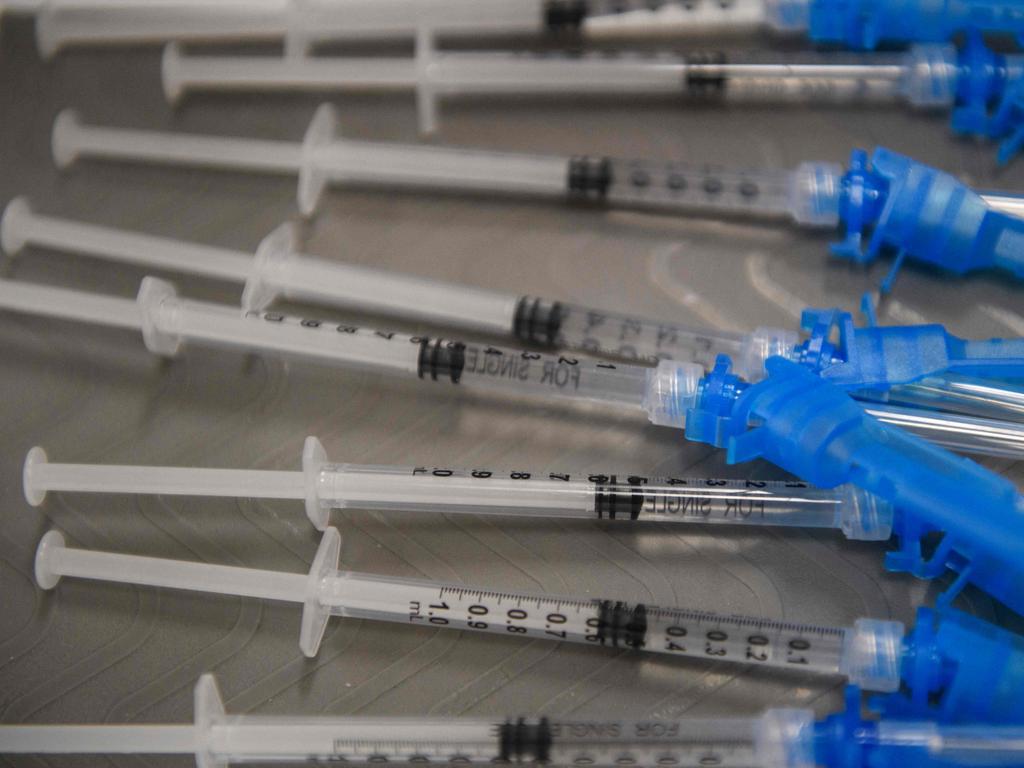Budget moves into new phase of economic high risk and targeted big-spending rewards
On May 11, the Treasurer will prioritise spending and push economic reform out to the distant horizon.

They’re some of the signal questions as the Treasurer prepares his third budget on May 11, just seven months after his second effort. Again, he will have the free political rein his predecessor custodians could not have imagined with crisis cover for missteps.
All the policy bias is on the side of spending too much, not too little. We’ve gone from an emergency setting to a new phase of targeted support and at some point on the electoral-fiscal continuum we will move into budget repair, or the narrative war will.
Back in October, Frydenberg’s task was simple and exquisite: spend big, spend wisely, spend temporarily. Not a butcher’s knife or apron anywhere.
That fiscal extravaganza, with an underlying cash deficit for the current financial year of almost $214bn, or 11 per cent of gross domestic product, was overwhelmingly about nationalising Australia’s payroll, keeping companies and families liquid, and providing incentives to businesses to hire and invest.
Budget season brings all manner of hoo-ha and, like every treasurer before him, Frydenberg relishes the theatre of it; political journalists, too, are conditioned to the rhythm of the set pieces, story drops and competitive speculation. But, when all is said and done, it’s spending and taxing.
And at this odd moment one metric dominates. Canberra’s payments this financial year were forecast to be $677bn or a staggering 34.8 per cent of GDP. That’s quite a footprint.
The jury is out on some of Frydenberg’s signature moves, such as the $74bn JobMaker scheme. The $4bn hiring credit, limited to workers aged up to 35 and purported to create 450,000 jobs over two years, has been poorly subscribed. Last month Treasury revealed only 609 people had been hired under the program, which now is likely to be redesigned.
The investment tax break allowing instant expensing has been a lurk for cashed-up tradies; vehicle sales have boomed, especially for twin-cab utilities that can cart a netball team around on Saturdays.

Business investment, anaemic before COVID, remains out of puff. The $2.5bn HomeBuilder grant scheme has added oxygen to a red-hot property market, a win or loss depending on where you are in the housing ecosystem.
As my colleague Patrick Commins has detailed, only a quarter of the $90bn JobKeeper program has been used for emergency income support for workers. Analysis by economic consultancy AlphaBeta suggests 16 per cent of the wage-subsidy cash went to workers who would have otherwise lost their jobs, while 9 per cent went to topping up the pay of recipients who had been earning less than the wage subsidy. The balance was a direct subsidy to businesses.
Still, the Treasurer can easily say “scoreboard”: two straight quarters of GDP growth, falling unemployment, robust household spending, rising business and consumer confidence, and a $240bn pile of private savings that will power up the revival. Frydenberg is frustrated the media, which has exposed government blind spots and a political culture that has enabled abuse and mistreatment of women, has not adequately told the economic success story.
The recovery in the labour market has been extraordinary, and not just because Treasury and Reserve Bank forecasters have been so off the mark in their estimates. In October, Treasury had forecast a peak in the jobless rate of 8 per cent in the March quarter; this was revised to 7.5 per cent two months later in the Mid-Year Economic and Fiscal Outlook.
On Thursday, labour force figures from the Australian Bureau of Statistics showed a 70,700 increase in employment, a rise in participation and a fall in the unemployment rate from 5.8 per cent to 5.6 per cent. The number of people in work is higher than before the pandemic; so too hours worked across the economy.
A fair amount of slack remains in the labour market. Treasury expects the end of JobKeeper on March 28 to put 100,000 to 150,000 people out of work. The buzz about jobs will be tempered when official figures roll in over coming months.
Still, the employment surge is taking everyone by surprise, even those people with privileged access to the electronic transfer of wages and welfare payments into customer accounts. Commonwealth Bank chief executive Matt Comyn told a parliamentary committee “the recovery in the labour market is, in one word, miraculous”.
Commonwealth Bank economists are expecting the unemployment rate to be 5 per cent by the end of this year and 4.7 per cent by the end of next year. The comparable estimates from the RBA’s baseline scenario in February were 6 per cent and 5.5 per cent. This difference matters as the Morrison government contemplates its medium-term fiscal strategies. Frydenberg had said the job of budget repair would start when the unemployment rate was “comfortably below 6 per cent and is around 5.25 per cent, or around 5.5 per cent”.
Deloitte Access Economics budget maven Chris Richardson said this week a virtuous circle is helping to repair the fiscal front, including savings on emergency support, more jobs, stronger commodity prices, better profits, robust consumer spending.
“The sensible aim is to keep doing exactly what we’re already doing, repairing budgets by repairing the economy,” he wrote in Deloitte’s Business Outlook.
“People assume that Australia faces a massive budget repair task. But it isn’t nearly as massive as you think, partly because the key lies in repairing the economy – that’s where most of the damage has been. The UK is looking to repay some of its COVID-driven debts over time. That approach may damage the economy over time, thereby blocking much of the budget repair it is intended to achieve”.
Let’s not do that Richardson argues. Instead the government should update that line in the sand around budget repair, moving it closer to the 4.5 per cent jobless rate the Reserve Bank uses.
Frydenberg said on Thursday he’d recalibrate the fiscal strategy and announce it ahead of budget night. It was “not a time for austerity measures”, putting a stake in the heart of the dwindling “debt and deficits” economic security hawks. Rebuilding fiscal buffers is not a priority.
Of course, recovery in the real economy means a lower welfare bill, more tax on higher profits. The iron ore bonanza is Treasury cream, especially for the “open-cut state”, where Scott Morrison and Anthony Albanese worked their FIFO magic this week.
By MYEFO, the budget’s bottom line had improved by $16bn; by the end of February it clawed back another $23bn, with total receipts $10.7bn higher and total payments $12.3bn lower than the 2020-21 MYEFO profile.
Even the bungled vaccine rollout will probably have a minimal adverse effect on the budget and the broader recovery, despite the likelihood that international borders will reopen later rather than sooner. It could, however, lead to more targeted support for workers and companies exposed to travel restrictions. That doesn’t mean the Prime Minister, the Treasurer and Health Minister Greg Hunt are off the hook. The vaccine program is central to recovery and confidence, as is nimble fiscal policy.
As Richardson has noted, the policy legacy of COVID is economic management has changed. The RBA used to smooth the bumps in the business cycle and budgets were focused on the medium term; but with near-zero interest rates Martin Place can do no more, although the RBA is likely to increase its quantitative easing program by as much as $100bn in coming months.
“For the foreseeable future, that says budget policy has to be more agile than it has been in times past, because the Reserve Bank has lost most of its ability to provide short-term steering for the ship of state,” Richardson says. “That means a greater willingness to use the budget to help juggle the ordinary ups and downs of the economy. But any moves of that type (such as tax surcharges and discounts and spending shifts) will necessarily need to be temporary, which will also require an understanding of that from both the public and from the opposition of the day.”
We know that after the royal commission’s findings aged care will be a big-ticket item on May 11. The big business lobby is calling for pro-growth settings, a broadbased 20 per cent investment allowance and assistance to winning industries that can turn our research into jobs of the future. It’s still a great time to go to Canberra asking for a handout.
This may not be a pre-election budget per se but this is a fat time for spending and a “recalibration” of priorities. Economy first, budget repair second. The rhetorical echo of last year’s statement — about jobs and infrastructure, investing in skills, creating incentives and giving the private sector a leg-up — will feature again. And that’s it. For diehards hoping for meaningful reform of the way we tax, work and regulate, the burning platform has been extinguished. We’re living in an era of ultra-cheap money and the political and fiscal dynamics scream buy now, pay later.






Is Josh Frydenberg a miracle worker? Can we trust Treasury at forecasting revenue, spending and unemployment? Is it time for budget repair? Who’s in control of the economy or vaccination program as we grapple with the shocks of COVID-19?